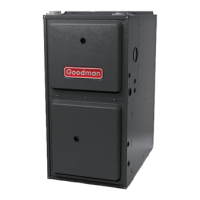39
.
Low Stage 1.6 - 2.2" w .c. 1.9" w .c.
High Stage 3.2 - 3.8" w .c. 3.5" w .c.
Low Stage 5.7 - 6.3" w .c. 6.0" w .c.
High Stage
The actual gas input rate to the furnace must never be
greater than that specied on the unit rating plate. To
measure natural gas input using the gas meter, use the
following procedure.
1. Turn OFF the gas supply to all other gas-burning
appliances except the furnace.
2. While the furnace is operating at high re rate, time
and record one complete revolution of the gas meter
dial, measuring the smallest quantity, usually the dial
If supply pressure diers from table, make the necessary
adjustments to pressure regulator, gas piping size, etc.,
and/or consult with local gas utility.
5. Turn OFF gas to furnace at the manual shuto valve
and disconnect manometer. Reinstall plug before
turning on gas to furnace.
6. Turn OFF any unnecessary gas appliances stated in
step three.
CAUTION
Only small variations in gas pressure should be made by
adjusting the gas valve pressure regulator. The manifold
pressure must be measured with the burners operating.
To measure and adjust the manifold pressure, use the
following procedure.
1. Turn OFF gas to furnace at the manual gas shuto
valve external to the furnace.
2. Turn o all electrical power to the system.
3. Outlet pressure tap connections:
White-Rodgers 36J54 valve: Back outlet pressure
test screw (inlet/outlet pressure tap) out one turn
(counterclockwise, not more than one turn).
4. Attach a hose and manometer to outlet pressure tap .
5. Turn ON the gas supply.
The furnace should be inspected by a qualied installer, or
service agency at least once per year. This check should
be performed at the beginning of the heating season.
This will ensure that all furnace components are in proper
working order and that the heating system functions
appropriately. Pay particular attention to the following
items. Repair or service as necessary.

